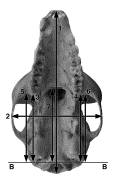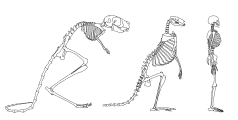Gabrielle A. Russo, E. Christopher Kirk
Source - http://www.sciencedirect.com/science/article/pii/S0047248413001681
Journal of Human Evolution
Abstract
The anterior position of the human foramen magnum is often explained as an adaptation for maintaining balance of the head atop the cervical vertebral column during bipedalism and the assumption of orthograde trunk postures. Accordingly, the relative placement of the foramen magnum on the basicranium has been used to infer bipedal locomotion and hominin status for a number of Mio-Pliocene fossil taxa. Nonetheless, previous studies have struggled to validate the functional link between foramen magnum position and bipedal locomotion. Here, we test the hypothesis that an anteriorly positioned foramen magnum is related to bipedalism through a comparison of basicranial anatomy between bipeds and quadrupeds from three mammalian clades: marsupials, rodents and primates. Additionally, we examine whether strepsirrhine primates that habitually assume orthograde trunk postures exhibit more anteriorly positioned foramina magna compared with non-orthograde strepsirrhines. Our comparative data reveal that bipedal marsupials and rodents have foramina magna that are more anteriorly located than those of quadrupedal close relatives. The foramen magnum is also situated more anteriorly in orthograde strepsirrhines than in pronograde or antipronograde strepsirrhines. Among the primates sampled, humans exhibit the most anteriorly positioned foramina magna. The results of this analysis support the utility of foramen magnum position as an indicator of bipedal locomotion in fossil hominins.

Figure 1. Measurements taken on each photographed cranium. B: Line through basion, perpendicular to midsagittal plane; 1: Maximum cranial length, as the distance from prosthion to opisthocranion; 2: Bizygomatic width, as the distance between the right and left zygion, perpendicular to maximum cranial length; 3 and 4: Basion line to the posterior margins of the distalmost molars; 5 and 6: Basion line to the anterior margins of the temporal fossae; 7: Basion line to the posterior margin of the hard palate in the midsagittal plane.

Figure 7. Comparison of the skeletons of three bipedal mammals: an Egyptian jerboa (Jaculus orientalis, left), an eastern gray kangaroo (Macropus giganteus, center), and a human (Homo sapiens, right). Skeletons of the jerboa and kangaroo were redrawn from digital photographs of mounted museum specimens, so the postures illustrated are only approximate.